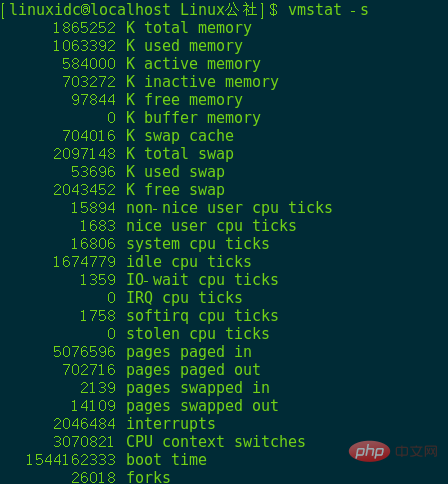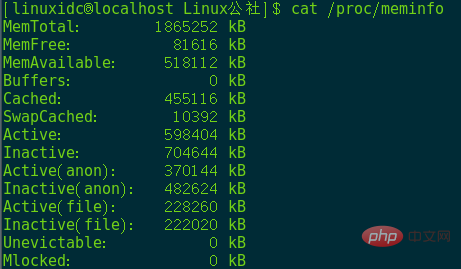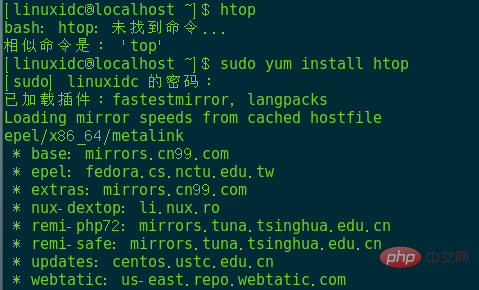 Operation and Maintenance
Operation and Maintenance
 Linux Operation and Maintenance
Linux Operation and Maintenance
 Several methods to check available memory size in Linux
Several methods to check available memory size in Linux
Several methods to check available memory size in Linux

As Linux users, especially administrators, we need to check how much memory resources the system uses and how many memory resources are free. Since the most important thing is to check the memory resources on the server, it is best to learn the relevant commands that can help us with server management.
This article explains the use of the following 5 commands to check available memory:
1, free command
2, vmstat command
3, /proc/ meminfo command
4, top command
5, htop command
By using these commands, you can always ensure that there are enough memory resources for running on the server. process. For example, if you're running a web server, you can make sure that missing resources don't slow down your site, or that it doesn't stop functioning entirely.
We ran the commands and procedures mentioned in this article on a CentOS 7.5 system, as well as on Ubuntu Linux.
To view memory usage, we use the Linux command line, terminal application. You can open the terminal via the system Dash.
Method 1: free command
Since the free command is the most widely used and undoubtedly the most useful, we will mention its usage first. This command is used to check information about system RAM usage. Here is the command you would enter in the terminal:

available column represents available memory.
The used column in the Swap entry is 51, which means it uses 51M and the free part is 1996M.
Free video tutorial sharing: linux video tutorial
Method 2: vmstat command
To view memory statistics through the vmstat command Information, you can use it in the following ways:

s tag provides detailed statistics about memory usage.
You can view Free Memory and Free Swap Memory entries in the output, indicating the available memory in the system.
Method 3: /proc/meminfo command
The following command extracts memory-related information from the /proc file system. These files contain dynamic information about the system and kernel, rather than real system files.
This is the command used to print memory information:

The output of this command is similar to the vmstat command. You can easily view free memory in MemFree results and available swap memory in SwapFree results.
Method 4: top command
The top command is used to print the CPU and memory usage of the system. You can use this command as follows:

In the header of the output you can see the KiB Mem and Kib Swap entries through which you can check the used and available memory resources.
Method 5: htop command
Just like the top command, the htop command also analyzes your CPU and memory usage in detail. If htop is not installed on your system, you can first update the abt repository to install it under Ubuntu by running the following command:
$ sudo apt-get update
Then enter the following command
$ sudo apt install htop
Use the following command to install under CentOS:
[linuxidc@localhost ~]$ sudo yum install htop


After installing htop, you can simply use the following command to print the required information:
[linuxidc@localhost ~]$ htop
Mem in title (Memory aka RAM) and Swp (Swap) entries represent used and total memory, through which the free memory available on the system can be calculated.
Using the commands we mentioned in this article, you can monitor the system process memory situation. You can not use the GUI at all and still check memory usage on your personal computers and servers.
Recommended related articles and tutorials: linux tutorial
The above is the detailed content of Several methods to check available memory size in Linux. For more information, please follow other related articles on the PHP Chinese website!

Hot AI Tools

Undresser.AI Undress
AI-powered app for creating realistic nude photos

AI Clothes Remover
Online AI tool for removing clothes from photos.

Undress AI Tool
Undress images for free

Clothoff.io
AI clothes remover

Video Face Swap
Swap faces in any video effortlessly with our completely free AI face swap tool!

Hot Article

Hot Tools

Notepad++7.3.1
Easy-to-use and free code editor

SublimeText3 Chinese version
Chinese version, very easy to use

Zend Studio 13.0.1
Powerful PHP integrated development environment

Dreamweaver CS6
Visual web development tools

SublimeText3 Mac version
God-level code editing software (SublimeText3)

Hot Topics
 1664
1664
 14
14
 1423
1423
 52
52
 1319
1319
 25
25
 1269
1269
 29
29
 1248
1248
 24
24
 Linux Architecture: Unveiling the 5 Basic Components
Apr 20, 2025 am 12:04 AM
Linux Architecture: Unveiling the 5 Basic Components
Apr 20, 2025 am 12:04 AM
The five basic components of the Linux system are: 1. Kernel, 2. System library, 3. System utilities, 4. Graphical user interface, 5. Applications. The kernel manages hardware resources, the system library provides precompiled functions, system utilities are used for system management, the GUI provides visual interaction, and applications use these components to implement functions.
 How to check the warehouse address of git
Apr 17, 2025 pm 01:54 PM
How to check the warehouse address of git
Apr 17, 2025 pm 01:54 PM
To view the Git repository address, perform the following steps: 1. Open the command line and navigate to the repository directory; 2. Run the "git remote -v" command; 3. View the repository name in the output and its corresponding address.
 vscode Previous Next Shortcut Key
Apr 15, 2025 pm 10:51 PM
vscode Previous Next Shortcut Key
Apr 15, 2025 pm 10:51 PM
VS Code One-step/Next step shortcut key usage: One-step (backward): Windows/Linux: Ctrl ←; macOS: Cmd ←Next step (forward): Windows/Linux: Ctrl →; macOS: Cmd →
 How to run java code in notepad
Apr 16, 2025 pm 07:39 PM
How to run java code in notepad
Apr 16, 2025 pm 07:39 PM
Although Notepad cannot run Java code directly, it can be achieved by using other tools: using the command line compiler (javac) to generate a bytecode file (filename.class). Use the Java interpreter (java) to interpret bytecode, execute the code, and output the result.
 How to run sublime after writing the code
Apr 16, 2025 am 08:51 AM
How to run sublime after writing the code
Apr 16, 2025 am 08:51 AM
There are six ways to run code in Sublime: through hotkeys, menus, build systems, command lines, set default build systems, and custom build commands, and run individual files/projects by right-clicking on projects/files. The build system availability depends on the installation of Sublime Text.
 What is the main purpose of Linux?
Apr 16, 2025 am 12:19 AM
What is the main purpose of Linux?
Apr 16, 2025 am 12:19 AM
The main uses of Linux include: 1. Server operating system, 2. Embedded system, 3. Desktop operating system, 4. Development and testing environment. Linux excels in these areas, providing stability, security and efficient development tools.
 laravel installation code
Apr 18, 2025 pm 12:30 PM
laravel installation code
Apr 18, 2025 pm 12:30 PM
To install Laravel, follow these steps in sequence: Install Composer (for macOS/Linux and Windows) Install Laravel Installer Create a new project Start Service Access Application (URL: http://127.0.0.1:8000) Set up the database connection (if required)
 git software installation
Apr 17, 2025 am 11:57 AM
git software installation
Apr 17, 2025 am 11:57 AM
Installing Git software includes the following steps: Download the installation package and run the installation package to verify the installation configuration Git installation Git Bash (Windows only)



